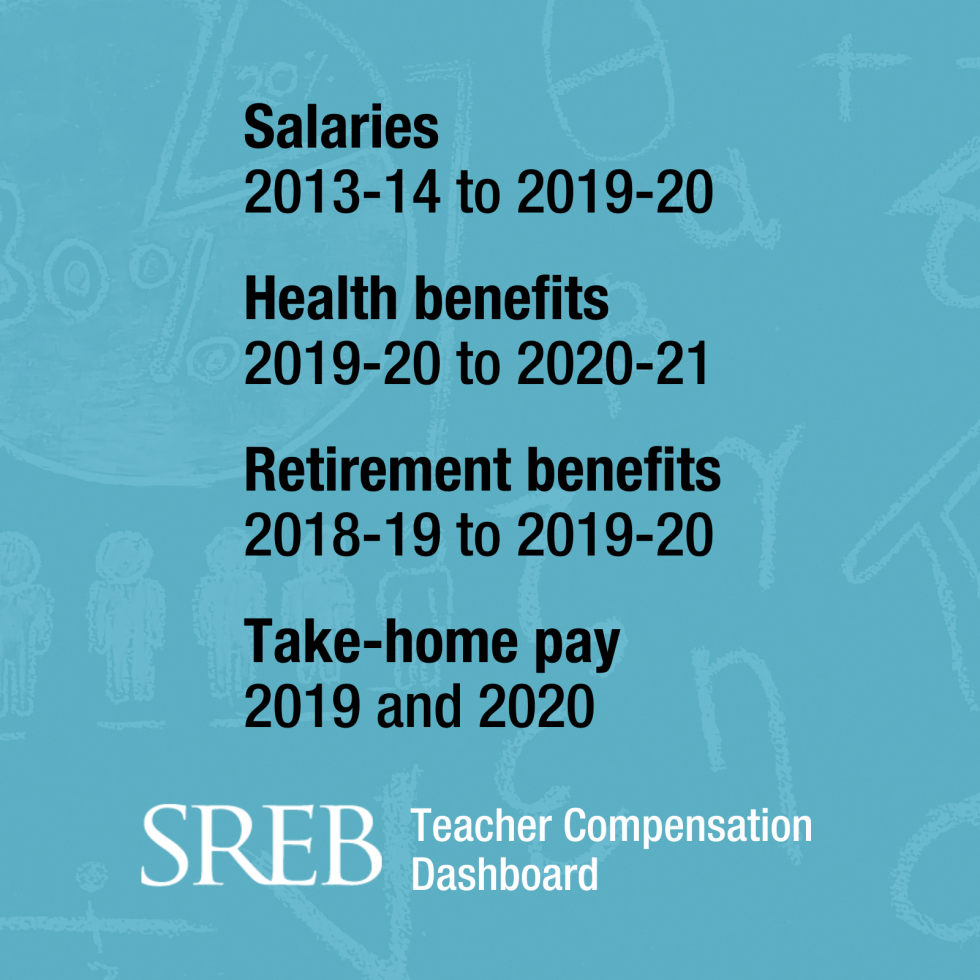To See Teacher Compensation, Look at More Than Salaries
Teacher Pay Is Increasing. So Is the Cost of Benefits
This spring, the National Education Association released its annual teacher pay analysis a bit earlier than usual. This data is widely used across the nation as the main source for average teacher salaries by state. The headline for 2021: Teacher salaries are going up by an average of 1.5% across the nation, and average spending per pupil is up 5%.
This is fantastic news ─ no bones about it.
It’s also not the whole story.
 A look at the full package of teacher compensation shows that many teachers don’t see the full raises in their take-home pay because employee health and retirement benefit costs have increased. Low take-home pay causes many teachers to seek second jobs – in fact they are three times more likely than U.S. workers overall to seek additional employment.
A look at the full package of teacher compensation shows that many teachers don’t see the full raises in their take-home pay because employee health and retirement benefit costs have increased. Low take-home pay causes many teachers to seek second jobs – in fact they are three times more likely than U.S. workers overall to seek additional employment.
To help decision-makers analyze teacher compensation with a big-picture view, we update the SREB Teacher Compensation Dashboard annually with data on teacher salaries — and also on health insurance and retirement costs. Linking these elements of compensation allows our take-home pay analysis.
Average net pay is calculated for a typical first-, 15th- and 35th-year teacher in each SREB state by taking the gross salaries for each and subtracting health plan premiums, minimum employee retirement contributions, and federal and state taxes. While this data doesn’t include a breakdown of supplements or bonuses some teachers get from their local districts or state incentive programs (or subtract the average $459 per year teachers spend out-of-pocket on school supplies), the numbers paint the basic picture of what a typical teacher brings home to support their household.
More than half of SREB states have raised teacher salaries in the last three legislative sessions, anywhere from 1% to an applause-worthy 10% or more. But states are also grappling with the rising costs of health benefits and paying out more and more for pensions as the baby boomer generation retires.
The overarching question that should drive our decisions: How dire is our state’s teacher shortage?
In many cases, states raise teacher salaries but pay less in health benefits or increase employee retirement contributions to balance overall costs. The result is that most teachers see very little increase in their paychecks.
To evaluate the full teacher compensation picture, SREB analyzed salary increases passed for the 2019-20 school year and compared that to our take-home pay analysis for the same year.
Salary Increases and Take-Home Pay
| State | Legislated Teacher Pay Raise for the 2019-20 School Year | Take-home Pay for Typical First-, 15th- and 35th-Year Teachers, 2019-20 | Percentage Change in Take-home Pay from 2018-19 |
|---|---|---|---|
| Alabama | 4% |
$30,344 (1st year) $37,585 (15th year) $48,319 (35th year) |
+3.8% +3.5% +3.0% |
| Arkansas | $1,000 |
$26,266 (1st year) $30,744 (15th year) $33,123 (35th year) |
+1.8% +1.9% +0.8% |
| Delaware | 2% |
$31,934 (1st year) $47,692 (15th year) $63,840 (35th year) |
+1.2% +3.8% +1.5% |
| Florida | $2,0001 |
$31,206 (1st year) $38,873 (15th year) $48,856 (35th year) |
+2.1% +1.7% +1.3% |
| Georgia | $3,000 2 |
$27,330 (1st year) $40,122 (15th year) $53,782 (35th year) |
+7.0% +5.4% +3.5% |
| Kentucky* | No statewide pay increase |
$25,528 (1st year) $31,516 (15th year) $37,294 (35th year) |
+28.8% +31.7% +7.0% |
| Louisiana | $1,000 |
$30,137 (1st year) $32,622 (15th year) $36,974 (35th year) |
+2.9% +1.6% +1.0% |
| Maryland | No statewide pay increase |
$34,998 (1st year) $54,085 (15th year) $68,171 (35th year) |
+4.4% +3.8% +2.5% |
| Mississippi | $1,500 |
$26,581 (1st year) $28,000 (15th year) Not Available (35th year) |
+4.1% +3.2% Not Available |
| North Carolina | No statewide pay increase |
$27,639 (1st year) $34,616 (15th year) $41,147 (35th year) |
-2.0% +0.3% +1.5% |
| Oklahoma | $1,220 3 |
$28,299 (1st year) $29,938 (15th year) $32,047 (35th year) |
+2.4% +4.1% +2.6% |
| South Carolina | 4% to 10.6% |
26,573 (1st year) $35,662 (15th year) $51,544 (35th year) |
+6.9% +3.7% +4.5% |
| Tennessee | 2.5% 4 |
$28,815 (1st year) $33,108 (15th year) $42,893 (35th year) |
+6.3% +0.8% +8.2% |
| Texas | $5,500 to $9,000 increase in statewide minimum salary schedule steps |
$30,588 (1st year) $28,036 (15th year) $33,078 (35th year) |
-1.8% +0.2% +1.6% |
| Virginia | 3% on July 1, 2019, plus an additional 2% on September 1, 2019 |
$30,245 (1st year) $41,153 (15th year) $51,657 (35th year) |
+2.3% +8.3% Not Available |
| West Virginia | 5% average |
$27,922 (1st year) $35,231 (15th year) $46,086 (35th year) |
+5.8% +5.5% +3.7% |
| Regional Averages |
|
$29,025 (1st year) $36,205 (15th year) $45,921 (35th year) |
+4.2% +4.6% +4.1% |
Note: Local districts may have increased local supplements, raising average teacher salaries.
1Salaries are determined at the local level via collective bargaining. Legislators appropriated funds sufficient to provide $2,000 across-the-board raises, but it is up to the districts to budget as such.
2 Funding for the raise was provided through the state funding formula, so non-formula-funded employees do not automatically receive it. Also, some districts have “strategic waivers” that may allow them to opt out of mandated salary increases.
3Districts were allowed to provide differentiated raises as long as the increases averaged $1,220.
4Legislators provided additional formula funds for the increases, but local districts determine funding allocations, and some teacher salaries are paid with non-formula funds.
*Kentucky’s take-home pay rose significantly in one year due to changes to state health insurance plans and contribution amounts to them. The state also made changes to retirement options that will take effect in 2022. This is a good example of the effect changes to benefits can have on take-home pay.
A bigger-picture look at compensation
As you can see, 10 of 16 SREB states averaged less than a 5% net pay increase for teachers. Teacher pay is not keeping up with the rate of inflation ─ which for 2021 is now at 5.4%.
Many other professions with salaried employees provide regular cost-of-living adjustments and potential performance-based increases. Yet teachers have seen their pay barely rise to levels dating back to the 1980s when measuring constant dollars.
Teacher health premiums are rising and were already exorbitantly high for family coverage ─ the average cost at or above $600 per month in five states. For health care in 2020-21, a teacher choosing employee-only coverage pays on average $139 a month, an 11.3% increase from 2019-2020. A teacher choosing family coverage saw a 0.8% increase from $624 to $629 per month.
And retirement contributions are trending upward as states use an increasing percentage of their employer contributions to pay benefits for those who have already retired. For example, in my state of North Carolina, the state contributes 12.29% to the pension system per teacher, but only 4.48% of this goes to the individual teacher’s benefit. This means that 7.81% goes to unfunded liabilities ─ what the state owes in current retiree benefit payments. (See the Retirement section of the SREB dashboard to find this “contribution to unfunded liabilities” percentage in each state).
Guiding questions for compensation policy
Let’s step back and evaluate teacher compensation with the full picture in view. If the goal is to reward teachers for their hard work and better recruit and retain talent, are we sending this message with our budgets?
State leaders in both the executive and legislative branches can come together to ask these questions to guide compensation policy and benefit changes:
- Is the pay raise we are considering high enough to offset the rising costs of health insurance plans offered by the state? If not, can we invest more to offset health premium costs?
- Will the pay raise we are considering offset any recent increase in teachers’ required contributions to the state retirement system?
- Does the salary raise we are considering keep up with the cost of living and rate of inflation in our state?
- How do our teacher pay and benefit policies compare to the other industries in our state that schools may be competing with for talent?
- Have we increased professional support for teachers in our state? The most effective supports include peer mentorship, content and pedagogical professional development, improving principal leadership and school culture. More teachers say they will stay in the profession, even without significant raises, if they are better supported.
- Does our compensation policy provide increased salaries for teacher leaders who take on increased responsibility and support more students and colleagues?
- Do we need to allot funding for more non-instructional support positions in each school such as nurses, counselors, teacher’s assistants, substitutes and administrative roles? This is important to evaluate as well, as every additional support role means teachers have experts to turn to for help with important student needs that make learning possible in the classroom.
The overarching question that should drive our decisions: How dire is our state’s teacher shortage? Understanding teacher compensation as more than just gross salary ─ as pay, benefits, support and perks altogether ─ will go a long way to keeping excellent teachers in the classroom.
Even more important: This broader view of compensation is one element ─ along with redesigning licensing and improving how we prepare and support teachers ─ in elevating the profession so we can also attract tomorrow’s educators to the profession and be sure every student has a great teacher.
Look for more of SREB’s work on teacher compensation policy redesign in our upcoming report on how to elevate the teaching profession.


